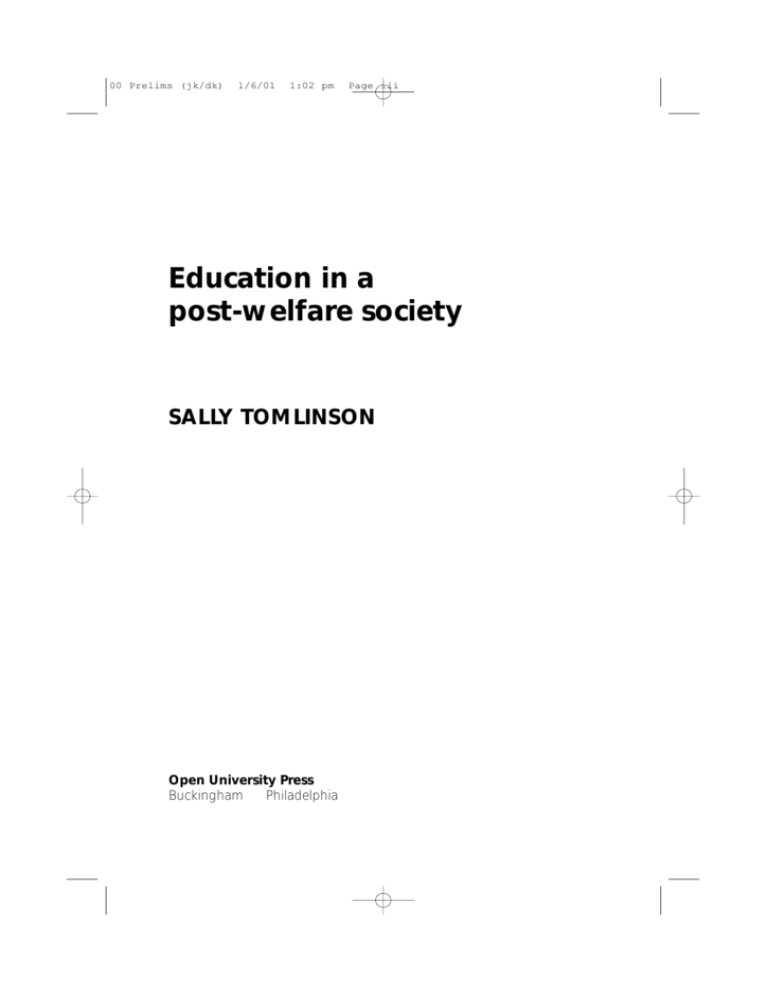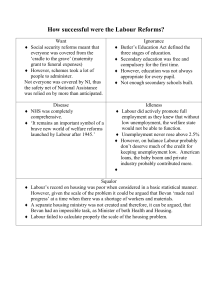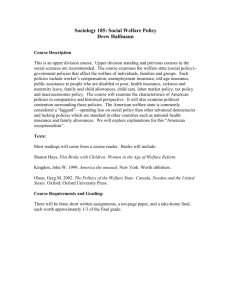
00 Prelims (jk/dk)
1/6/01
1:02 pm
Page iii
Education in a
post-welfare society
SALLY TOMLINSON
Open University Press
Buckingham • Philadelphia
00 Prelims (jk/dk)
1/6/01
1:02 pm
Page iv
Open University Press
Celtic Court
22 Ballmoor
Buckingham
MK18 1XW
email: enquiries@openup.co.uk
world wide web: www.openup.co.uk
and
325 Chestnut Street
Philadelphia, PA 19106, USA
First Published 2001
Copyright © Sally Tomlinson, 2001
All rights reserved. Except for the quotation of short passages for the purpose of
criticism and review, no part of this publication may be reproduced, stored in a
retrieval system, or transmitted, in any form or by any means, electronic, mechanical,
photocopying, recording or otherwise, without the prior written permission of the
publisher or a licence from the Copyright Licensing Agency Limited. Details of such
licences (for reprographic reproduction) may be obtained from the Copyright
Licensing Agency Ltd of 90 Tottenham Court Road, London, W1P 0LP.
A catalogue record of this book is available from the British Library
ISBN 0 335 20288 8 (pb)
0 335 20289 6 (hb)
Library of Congress Cataloging-in-Publication Data
Typeset by Type Study, Scarborough, North Yorkshire
Printed in Great Britain by Biddles Limited, Guildford and Kings Lynn
00 Prelims (jk/dk)
1/6/01
1:02 pm
Page vii
Contents
List of boxes
Series editor’s foreword
Acknowledgements
List of abbreviations
Introduction
Themes of the book
Human capital in a post-welfare society
Plan of the book
Notes
Further reading
xi
xii
xiv
xv
1
2
4
5
7
8
1
Social democratic consensus? Education 1945–79
Equalizing opportunity 1945–60
Comprehensive struggles
Demons of the 1960s
The 1970s
Ruskin and after
Ideology in the 1970s
Note
Further reading
9
11
14
16
19
21
22
23
23
2
Market forces gather: education 1980–87
Education Secretaries of State
Shadow Education Secretaries
Regressive vision
Selection and privatization
Special selection
24
26
26
27
28
31
00 Prelims (jk/dk)
viii
1/6/01
1:02 pm
Page viii
Education in a post-welfare society
Ethnic minorities
School governance
Centralizing control
Teacher control
Curriculum control
Vocational education
Towards serious reform
Notes
Further reading
32
33
34
36
37
39
40
42
42
3
Creating competition: education 1988–94
Education Secretaries of State
Shadow Education Secretaries
Education Reform Act 1988
Choice and diversity
Chaos and perversity
Legislation for inspection
The longest Education Act ever
Curriculum control
Curriculum critiques
Higher education
Teachers and their training
Labour education policies in the early 1990s
Notes
Further reading
43
45
46
46
49
50
53
53
56
57
59
61
63
65
66
4
The consequences of competition: education 1994–97
Education Secretary of State (from July 1995 Secretary of
State for Education and Employment)
Shadow Education Secretary
Legislation 1995–96
The final Tory Act
The effects of market forces
Failing schools
Special educational needs
Curriculum issues
Ages 14–19 and the academic–vocational divide
Labour policies
Notes
Further reading
67
69
69
69
71
72
74
76
77
79
81
83
84
New Labour and education: 1997–2000
Secretary of State for Education and Employment
Shadow Education and Employment Secretaries
85
89
89
5
00 Prelims (jk/dk)
1/6/01
1:02 pm
Page ix
Contents
ix
School policies
School Standards and Framework Act 1998
Selection and specialization
Tackling exclusion
Centralizing governance
Notes
Further reading
89
94
96
99
104
110
111
6
Centralizing lifelong learning
Lifelong learning
Learning to succeed
Learning and Skills Bill
Higher education
Policies and qualifications 14–19
Continuity and change 1997–2000
Notes
Further reading
112
114
116
119
121
122
124
126
126
7
Education and the middle classes
Changing class structures
Meritocracy and attainment
School effectiveness
Middle class needs
Private advantage
Choice and advantage
Avoidance of the vocational
Avoiding the poor
Class and the common good
Notes
Further reading
127
128
130
132
132
135
136
137
138
140
140
141
8
Equity issues: race and gender
Race and ethnicity
Gender
Girls’ achievements
Boys’ ‘underachievement’
Notes
Further reading
142
142
148
150
151
152
153
9
Education and the economy
Recent history
The labour market in the 1990s
Jobs and education
A new economy?
154
155
157
158
159
00 Prelims (jk/dk)
x
1/6/01
1:02 pm
Page x
Education in a post-welfare society
The global economy and education
Prospects for the poor
Notes
Further reading
160
162
164
164
Conclusion: education in a post-welfare society
Positive aspects
Negative aspects
The future
Notes
166
167
168
170
171
References
Index
172
191
00 Prelims (jk/dk)
1/6/01
1:02 pm
Page xii
Series editor’s foreword
Welcome to the second volume in the Introducing Social Policy series. The
series itself is designed to provide a range of well-informed texts on a wide
variety of topics that fall within the ambit of Social Policy Studies.
Although primarily designed with undergraduate Social Policy students in
mind, it is hoped that the series – and individual titles within it – will have a
wider appeal to students in other Social Science disciplines and to those
engaged on professional and post-qualifying courses in health care, education and social welfare.
The aim throughout the planning of the series has been to produce a series
of texts that both reflect and contribute to contemporary thinking and
scholarship, and which present their discussion in a readable and easily
accessible format.
‘Education, education, education’ was a central theme of Labour’s election campaign in the UK in 1997. Not surprisingly, therefore, Sally Tomlinson’s contribution to the series sets out the policy initiatives of New
Labour’s period in office. These she locates within the context of educational
reform and change over the period of the past fifty years: a period that began
with the 1944 Education Act, one of the centrepieces of the social legislation
that created Britain’s ‘classic’ welfare state. Her narrative provides a clear
and concise introduction to the policy changes and the influences that have
shaped them between the vision of equality of educational opportunity
enshrined in the 1944 Act and the increasingly diverse system of schooling
that prevailed at the beginning of the new millennium.
Over that same period as Tomlinson points out, more people have been
educated to a higher level, yet media headlines continually portray a schooling system that is failing and in crisis. Meanwhile, in that time, the objectives and purposes of schooling have also undergone considerable change.
From being a means and strategy directed towards social change and social
00 Prelims (jk/dk)
1/6/01
1:02 pm
Page xiii
Series editor’s foreword
xiii
inclusion, over the past twenty years educational policies have increasingly
been directed towards maximizing individual opportunity – by preparing
people for maximum economic productivity throughout their lives – and
national output by enhancing the quality of the workforce and, therefore,
economic growth and productivity.
All these – and many other themes – Sally Tomlinson discusses with
vigour, scholarship and personal commitment. In the process she provides
an acute analysis of the past and the present and raises important questions
about the future of education in a more competitive, globalized and postwelfare society.
David Gladstone, University of Bristol
01 Intro (jk/d)
1/6/01
1:03 pm
Page 1
Introduction
The major purpose of this book is to provide a critical overview of educational policy over the past fifty years, a period during which government
in the UK moved from creating a welfare state, to promoting a post-welfare
society dominated by private enterprise and competitive markets. Over the
period there has been a shift from a relatively decentralized education system
to a centralized system in which funding, teaching and curriculum are centrally controlled, and the subjection of schools to market forces has
increased social and academic divisions. Education was central to post-war
social reconstruction, and the Education Act (1944), along with the National
Insurance Act (1946) and the National Health Service Act (1948), was
regarded as one of the three pillars of the welfare state. In the post-welfare
society there has been a fragmentation of social welfare programmes via the
introduction of market principles. By 2000, education, subject to these principles, had become a competitive enterprise and a commodity, rather than a
preparation for a democratic society. Despite a plethora of reforms the education system did not appear to serve either the needs of the society or the
needs of individuals satisfactorily. It could not be regarded as a pillar of a
post-welfare society.
The justification for yet another book on education policy is that many
people, teachers, students and parents in particular, remain confused by the
welter of legislation – the Acts, circulars, regulations, the consultation and
curriculum documents, and the ‘initiatives’ which have emanated from
government, especially since the late 1970s. There is also confusion about
the political focus and ideological purposes behind educational change. This
is partly due to a rhetoric that the state has given more freedom to individuals, while in reality central control has tightened. Before the 1992
general election, a group of university professors, supported by Fred Jarvis,
former General Secretary of the National Union of Teachers (NUT),
01 Intro (jk/d)
2
1/6/01
1:03 pm
Page 2
Education in a post-welfare society
declared in a letter to the Guardian that a modern society could not prosper
with a narrow education base and socially divisive hierarchies of schools,
that government should treat education as a public service and not as a commodity to be traded in the marketplace, and that high quality education
should not be reserved for some children in some schools.1 The professors,
and countless others with an interest in education, were disappointed when
a Conservative government, elected for a fourth successive term since 1979,
moved even further to subject schools to the operation of market forces and
centralize control of all aspects of the education service. There was even
more disappointment and much disillusionment when a Labour government, elected in 1997, continued to pursue Conservative market policies,
effectively negating some of its more ameliorative policies which were
intended to return a measure of social justice to an education system becoming increasingly divisive and divided.
Themes of the book
The storylines in this book will be familiar to those with an interest in education. Since the late 1940s more people have been educated to higher levels
than ever before, but education is constantly portrayed, especially by some
sections of the media, as failing or in crisis. There has been continued
antagonism to equity in education – elitists arguing for selection for superior
and better resourced kinds of education, usually described as academic, for
a minority, others to be offered a practical or vocational education. Those
committed to equality continued to argue for a meritocracy based on equality of opportunity, which presumed an equal start, unencumbered by welldocumented social class inequalities. The middle classes, who historically
have always claimed more than their fair share of superior forms of education, discovered or were offered new ways to do this. Governments
around the world, who were turning their welfare states into post-welfare
societies, were rediscovering human capital theory, with individuals told to
invest in themselves in a lifelong process of learning and re-skilling in order
to get or retain any kind of job. Teachers were being gradually stripped of
their professionalism and policed by new inspection regimes. Schools,
teachers and local education authorities were increasingly held responsible
not only for failing individuals, but also for failing to make the national
economy competitive in global markets. The roles and responsibilities of
local education authorities (LEAs) were increasingly diminished, and the
role of private contractors and business entrepreneurs expanded. A language
and practice of managerialism, of accountability, inspection, testing and targets, precluded debates about the purposes of education beyond preparation
for the economy.
For those who remembered Britain pre-1939, when 88 per cent of young
01 Intro (jk/d)
1/6/01
1:03 pm
Page 3
Introduction
3
people left school by 14, and those who grew up in the post-war period benefiting from the Education Act 1944 and free secondary education for all, the
period 1945 to 1979 was an optimistic one. Education policy was largely
based on a social democratic consensus that governments should regulate
and resource education to achieve redistributive justice, and provide equal
opportunity. Although it soon became apparent that the educational opportunities offered by the 1944 Act largely benefited middle class children, along
with a small number of selected working class children, and that the rich and
influential did not attend state-maintained schools, the optimistic feeling persisted. It was encouraged by an expanding economy and relatively full and
secure employment. It seemed that, for the first time in the history of public
education, there was a real intention to educate the mass of young people to
far higher levels than ever before. The development of comprehensive education from the 1960s appeared to signal an end to education as a vehicle for
the perpetuation of social class divisions and raised the hope that the talents
of the whole population could be put to new social and economic use.
From 1979, however, the radical restructuring of public welfare provision
in the UK began to take shape. Reforms of the health and education services,
and of housing, social and legal services, were undertaken by the Conservative governments of Margaret Thatcher and John Major, and continued
under the New Labour government of Tony Blair. The introduction of
market forces and competition, the licence given to people to pursue personal and familial profit, and a diminished emphasis on redistribution,
equity and social justice resulted, by the 1990s, in a dramatic increase in
social and economic inequalities and enhanced disadvantages for particular
groups (Hutton 1995; Smith and Noble 1995; Pantazis and Gordon 2000).
By the later 1990s the ‘social exclusion’ of groups and individuals from full
participation in society had become a worrying legacy of an ideological commitment to the workings of market forces, and a focus for intense political
attention (Blair 1997b). From the 1960s, western governments had focused
on the disadvantaged, later the underclass, and then the socially excluded,
as victims of economic exclusion and poverty. In the 1990s social exclusion
became a metaphor for anxieties over crime, antisocial behaviour and welfare fraud. In education, people became fearful of their children attending
schools with those bearing the hallmarks of exclusion.
By the 1990s optimistic feelings about education had been replaced by
anxiety and uncertainty among a growing number of parents and educators.
Post-war welfare state policies based on the notion of partnership between
central and local government and teachers had disappeared, and education
had moved from being largely decentralized to decision-making located
almost entirely in the central political arena. Enhanced central control and
regulation encompassed the teaching profession. Almost every aspect of the
education system had been reformed and restructured, and the belief that
educational resources would be shared more fairly had shrivelled back to the
01 Intro (jk/d)
4
1/6/01
1:03 pm
Page 4
Education in a post-welfare society
pre-war belief that a good education was a prize to be competitively sought,
not a democratic right.
Human capital in a post-welfare society
Postindustrial governments, notably in the USA and UK, had by the 1990s
put the work ethic and competition in the labour market at the policy centre
(Jordan 1998). Policy-makers were aware that the needs of global capitalist
economies were a major influence on local and national economies and
assigned education a major role in improving national economies. Institutions and individuals were required to ‘learn to compete’ (Department for
Education and Employment (DfEE) 1996a) as never before. Governments of
varying political persuasions around the world rediscovered human capital
theory (Vaizey 1958; Becker 1964), a theory which suggested that improving people’s skills and capabilities makes them act in new productive ways,
and assumed that investment in education will improve the quality of the
workforce, which will in turn improve economic growth and productivity.
By the 1990s government was firmly committed to the belief that only
greater investment in human capital would enable the country to compete in
the new global economy. As the DfEE pamphlet put it, ‘Investment in learning in the 21st Century is the equivalent of investment in the machinery and
technical innovation that was essential to the first industrial revolution.
Then it was capital, now it is human capital’ (DfEE 1996a: 15).
There was certainly an argument to be made for regarding young people
as human capital and persuading them that continuous education, reskilling and lifelong learning were in their own best interest, as evidence
mounted that the educational and vocational qualifications of young British
people were lower than in countries considered as economic competitors
(Green and Steedman 1997). Although Robinson (1997, 1999) consistently
pointed out that there was little evidence on the actual relationships between
school performance, credentials and national economic competitiveness, the
notion that educating and training all young people to higher levels might
help them to face an uncertain globalized future, slowly became more
acceptable in Britain.
The New Labour government, elected in 1997, made education, training
and work central to its search for a ‘Third Way’ in politics, attempting to
unite individual liberalism with a measure of social justice, and with partnerships between state, private and voluntary sectors. Prime Minister Blair
declared in 1998 that ‘The Third Way approach to the challenge of modern
employment is about extending welfare to work . . . and investing in the
skills people need in a more insecure and demanding labour market’ (Blair
1998b: 9). In a modernized Britain the young human capital was to regard
education as a preparation for the economy and not much else.
01 Intro (jk/d)
1/6/01
1:03 pm
Page 5
Introduction
5
However, no government up to the turn of the century came near to
resolving the contradictions involved in greater investment in education and
training for all, in a society that still regarded educating the working class
and socially excluded with ambivalence and had not yet managed to come
to terms with the moderate success of welfare state education. The status
division between academic and vocational education persisted. Expanded
secondary and tertiary education which allowed more people to acquire credentials created anxiety among the middle classes, who feared increased
competition and manoeuvred for the positional advantage described by
Hirsch (1977). Disadvantaged groups found raised hurdles and moved goalposts in the struggle to acquire qualifications. The increasingly competitive
nature of education meant further control of the reluctant, the disaffected
and those ‘special needs’ groups who were unlikely to join the economy at
any but the lowest levels, but whose presence might interfere with the prescribed education for the majority. As Ellison delicately commented: ‘The
stress is on individual achievement underscored by a state whose enabling
role masks a certain coercive dimension’ (Ellison 1997: 55).
Plan of the book
The first six chapters of the book offer a descriptive review of Acts, reports
and events in education between 1945 and 2000. As an aide-memoire to
readers, these are summarized in a list near the beginning of each chapter,
and the main sections of major Acts are summarized in boxes. Finch (1984),
examining education as social policy in the thirty-five-year period 1944 to
1979, summarized major events in a table that contained only three Education Acts, one of these being an Act by which Thatcher, then Secretary of
State for Education, removed the entitlement of free school milk for all children – a move which earned her the label ‘Mrs Thatcher, milk snatcher’.2
During the twenty-year period 1980 to 2000, over thirty Education Acts
were passed, with hundreds of accompanying circulars, regulations and
statutory instruments.3 After the Education Reform Act 1988, described by
one journalist as a gothic monstrosity of legislation, literally thousands of
curriculum documents, working group reports and other documents were
produced. The New Labour government promised that ‘Education, Education, Education’ would be a major focus of government, and continued
the pace of reform and the avalanche of documentation. No one book can
do justice to all this activity, and the review of events is necessarily selective.
Chapter 1 briefly overviews education as central to the creation of a welfare state attempting to redistribute social goods and resources more
equitably, charting the development of comprehensive education and the
persistence of opposition to non-selective schooling. The chapter notes
that the 1960s, actually a period of considerable educational advance and
01 Intro (jk/d)
6
1/6/01
1:03 pm
Page 6
Education in a post-welfare society
innovation, have been consistently demonized by right-wing politicians and
sections of the media as a period of liberal anarchism, and an important aim
of the Thatcher governments in the 1980s was to reverse the democratic and
egalitarian education policies of the 1960s.
Chapter 2 overviews the education policies of the incoming Conservative
government from 1979 to 1987, the period when liberal individualism,
moral authoritarianism and nostalgic imperialism translated into a partial
dismantling of a democratically controlled education system and its eventual
replacement by schools with centrally controlled funding and curricula. The
chapter notes policies on selection and privatization, special educational
needs, ethnic minorities, school governance, teachers and curriculum. Chapter 3 documents the period 1988 to 1994, a period when one or more Education Acts were passed each year and those working in education began to
be overwhelmed by the reforming zeal of the Conservative government.
Long-term strategies to change the whole system of education from nursery
to higher education became apparent during this period. The chapter
reviews the Education Reform Act 1988 and the 1992 White Paper which
extolled ‘choice and diversity’ in schooling and decided that schools as well
as individuals could be labelled as ‘failures’. The Education Act 1993 (the
longest Act ever), legislation for new inspection regimes and higher education reform, including teacher training, are described. This chapter and
the following one conclude with a comment on Labour policies being developed in opposition.
Chapter 4 covers the period 1994 to 1997, describing the attempts to
recreate a selective system of schooling via grant-maintained (GM) schools
and a three-track route for pupils from 14 into academic, vocational or
work-oriented courses. The increasing educational divide along social class
lines, exacerbated by ‘choice’ and the publication of league tables of examination results, is noted. The chapter covers the consolidating Acts passed on
the recommendation of the Law Commission to clarify the spate of legislation, and the final legislation by the Conservatives, some of which was
repealed by the incoming Labour government, the effects of market forces,
especially on failing schools and those with special needs and disabilities,
and the political convergence of plans to boost literacy and numeracy and
education 14–19.
Chapter 5 covers New Labour’s policies for schools between 1997 and
2000, which exhibited considerable continuity with Conservative policies.
In particular it notes the retention of market principles of ‘choice’ and competition between schools fuelled by league tables, the policing of schools by
Ofsted, an emphasis on standards of basic literacy and numeracy, and a relabelling of existing schools. This together with the creation of specialist
schools ensured the continuation of a divided and divisive school system.
The chapter covers the 1997 White Paper and the Schools Standards and
Framework Act 1998, policies for the poor, the disaffected and those with
01 Intro (jk/d)
1/6/01
1:03 pm
Page 7
Introduction
7
special educational needs, and policies directed towards ‘modernizing’ LEAs
– particularly by privatizing services – the teaching force and the curriculum.
Chapter 6 documents post-16 and higher education policies 1997 to 2000,
noting again the continuities from the previous government, with investment in human capital and the subordination of education and training to
the needs of the economy being dominant themes. The chapter covers policies on lifelong learning and the White Paper preceding the Learning and
Skills Act 2000, higher education and 14–19 policies. The chapter concludes
with a comment on New Labour’s spending on education to 2000.
Chapters 7, 8 and 9 briefly review the effects of education policy changes
and reforms in terms of social class, ethnicity and gender, and consider links
between education and the economy. There is a very large literature in all
these areas and the chapters are intended to provide an overview and guide
to further reading. Chapter 7 discusses changing class structures and the
effect of reforms on the middle classes. The advantages conferred on middle
class and aspirant groups by choice policies and policies which enable an
avoidance of the poor are noted. Chapter 8 reviews the partially successful
efforts to eliminate racial and gender inequities in education since the 1940s,
the negative effects of choice policies on minorities generally, and the 1990s
moral panic over the achievements of working class boys. Chapter 9 reviews
links between education and the economy as work has become more knowledge ‘intensive’, and affected by global economic factors, and looks at the
prospects for the poor in an increasingly socially divided society.
The book concludes with a brief assessment of the positive and negative
impacts of educational policies since the late 1940s and the effects of the
short- and long-term educational agenda in the UK up to and beyond the
end of the twentieth century. It suggests that in the longer term there will be
a reaction against a centrally imposed curriculum, never-ending assessment
and inspections, control of educational institutions and a narrow economistic view of the purpose of education. An overall conclusion is that education has moved from being a key pillar of the welfare state to being a prop
for a global market economy.
Notes
1 The Guardian letter was followed up by the publication by the fourteen professors of Education: A Different Vision (1993) edited by Ted Wragg and Fred Jarvis.
2 There were a number of other Education Acts between 1945 and 1979, mainly
specifying the responsibilities of LEAs and schools, setting up middle schools, and
establishing teacher negotiating procedures. An Employment and Training Act in
1947 established the Careers Service, a London Government Act created the Inner
London Authority in 1963 and a Local Government Act in 1966 established the
rate support grant and allocated funds for the education of New Commonwealth
immigrant children.
01 Intro (jk/d)
8
1/6/01
1:03 pm
Page 8
Education in a post-welfare society
3 Statutory Instruments (SIs) are used to make orders of general application. They
need not go before Parliament although Parliament can object to them. Regulations can be made and imposed by the Secretary of State. Circulars are documents circulated by government departments for information and comment. In
this book legislation referring to England, Wales and Scotland is noted; Northern
Ireland is not covered.
Further reading
Finch, J. (1984) Education as Social Policy. London: Longman. This book is one of
the few which discusses educational policy in the wider context of social policy
1945–79.
Jordan, B. (1998) The New Politics of Welfare. London: Sage. This important book
analyses the emerging politics of welfare, which stresses the importance of a
work ethic in a global context. Chapter 4 suggests ways of restraining competition for positional advantage in education.
Philips, R. and Furlong, J. (eds) (2001) Education, Reform and the State: TwentyFive Years of Politics and Practice. London: Routledge. This edited collection
examines different aspects of education policy and practice since 1976, clarifying factors which have shaped contemporary education provision and debate.
Wragg, T. and Jarvis, F. (eds) (1993) Education: A Different Vision. London: Institute for Public Policy Research. There are not many books which offer alternative visions of education. The views offered in this short publication are still
relevant.









